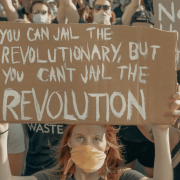Since November 15, protests have swept through Iran, erupting in at least 165 cities. Ostensibly triggered by a gasoline price hike of up to 300%, the unrest soon found a new focus: the overthrow of the ruling regime in its entirety.
The speed with which the protests spread was a clear indication that the explosive society was just waiting for an opportunity to call for regime change. In the first two days, the protests spread to over 100 cities, with unified chants of “death to the dictator.” “death to Rouhani,” “death to Khamenei,” and “neither Gaza nor Lebanon, I give my life for Iran.”
The public’s thirst for change and penchant to stand up to the regime far exceed that seen in the 2018 uprising. On day one, people closed streets, tore down or burned posters of Supreme Leader Ali Khamenei, and attacked government buildings. According to the state-run Fars News Agency affiliated with the Islamic Revolutionary Guards Corp (IRGC), in only one province, 100 state-owned banks and 56 other government locations were set ablaze in the first two days; that is double the number in the entire country in 2018. According to our information, over 1,300 government buildings, banks, Bassij headquarters, and clerical seminaries have been attacked and set ablaze, unprecedented in the past three decades.
Sensing a growing fissure within the three branches of his regime, Khamenei spoke on day two, endorsing the price hike and ordering the security forces to crack down. In the first two days, at least 61 people were killed, more than all those killed in 2018.
Tehran doubled down on the use of violence after Khamenei’s ominous speech, killing at least 251, injuring over 3,700 and arresting more than 7,000 as of this writing. But the brute force failed to stop the protesters, and by the second day the regime shut down the internet despite a massive international backlash and financial losses estimated at $370 million a day.
Still, the unrest continued.
Four Decades of Oppression
There is nothing spontaneous about these protests, as the regime’s leaders have conceded. The editorial in the state-run Jomhouri newspaper on November 19th is telling: “The rioters operated in groups of a few individuals at predetermined locations guided by a certain command center, caused damage, set fires, provoked people, chanted slogans not related to gasoline rationing and the price rise … Their aim was something more important than causing a riot.” In his Nov 17th speech, Khamenei pointed to the main Iranian opposition organization, the Mujahedin-e Khalq (MEK), which has a vast network in Iran including its Resistance units, as well as a significant presence abroad.
The conscience of the nation is coming back to haunt the regime. The Friday prayer leader of Rasht said on Nov 20th that the main organizers of the protest cells are “the children of the MEK members who were executed,” referring to the 1988 massacre of 30,000 political prisoners.
The root cause of the uprising is 40 years of repressive rule. The clerics’ plundering of the wealth and dignity of a nation, astronomical corruption, denial of basic freedoms, and suppression of women are over the top.
Some have argued that as during previous protests, the regime would weather the storm. Not so. This uprising clearly has one message, which is not about “moderates,” vs. “radicals”; it is all about the overthrow of the entire clerical system along with their repressive forces, e.g., the IRGC. The gains of the 2018 uprising turned the page, which has now opened a new chapter. Whatever ups and downs ahead, this marks the beginning of the end of the regime. The situation will never return to what it was.
The maximum pressure policy by the United States has played its part, and did not rally the Iranian people around the flag, as some armchair pundits predicted in Washington. To the contrary, people increasingly see the regime as the main cause of their economic misery and lack of freedom.
And things will only get worse for the mullahs. Weeks before, the Iraqi people – led by the Shiite majority – revolted against their regime, calling for an end to Iranian influence in their country, as did the Lebanese people in their quest to dethrone Hezbollah. A new era has begun.
President Trump, Vice President Pence, and bi-partisan congressional leaders have condemned the killings and sided with the protesters. It is time to recognize the right of the Iranian people to change the repressive regime and establish a democratic, pluralistic and non-nuclear republic based on separation of mosque and state. Providing a safe and secure internet to the Iranian people that cannot be blocked by the regime would be a tangible step in that direction.
Alireza Jafarzadeh is the deputy director of the Washington office of the National Council of Resistance of Iran.








